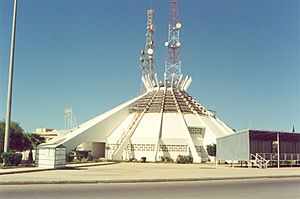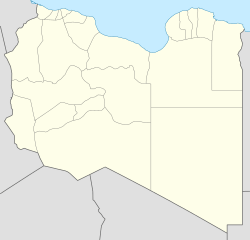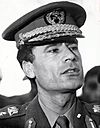Sirte facts for kids
Quick facts for kids
Sirte
سِرْت
|
|
|---|---|

Mathābah al-Madīnah, Assembly building, in Sirte (2007)
|
|
| Country | |
| Region | Tripolitania |
| District | Sirt |
| Elevation | 28 m (92 ft) |
| Population
(2013)
|
|
| • Total | 128,123 |
| Time zone | UTC+2 (EET) |
| License Plate Code | 7 |
Sirte (/ˈsɜːrt/; Arabic: سِرْت) is a city in Libya. It is also spelled Sirt, Surt, Sert, or Syrte. The city is located south of the Gulf of Sirte. It sits almost exactly halfway between Tripoli and Benghazi.
Sirte is known for its history of battles and its connection to Muammar Gaddafi. It briefly became the capital of Libya in 2011. This happened after Tripoli was taken during the First Libyan Civil War. The city was first built in the early 1900s by the Italians. It grew around an old fortress from the 1800s. Sirte became a much larger city after World War II.
Many people thought Sirte was Muammar Gaddafi's birthplace, but this is not true. He was born in a village called Qasr Abu Hadi, about 20 kilometers south of Sirte. This village was home to farmers. During Gaddafi's time in power, Sirte was a favored city. It received a lot of support from his government. Sirte was the last major place where Gaddafi's supporters held out in the 2011 civil war. Gaddafi died there on October 20, 2011. After the battle, Sirte was heavily damaged. Many buildings were destroyed or harmed. However, within six months, most people had returned to their homes.
Contents
History of Sirte
Ancient Times
Sirte is built near an old Phoenician city called Macomedes-Euphranta. This ancient city was an important stop along the Mediterranean Sea coast. It was one of the last places where the Punic language was spoken, around the 5th century CE. For many centuries, this area was known for bandits. Ancient writers like Virgil described the coast as dangerous for ships.
The medieval city of Surt was about 55 kilometers east of today's Sirte. After the Umayyad conquest of North Africa, Berber people settled in Surt. They became Ibadi Muslims in the mid-8th century. Early descriptions of Surt, like one from Ibn Hawqal in 947, say it was a walled city. It had strong walls made of mud and brick. The people stored rainwater in cisterns. They farmed dates, grapes, and other fruits. They also raised goats and camels. Another important local business was alum mining.
The Fatimid rulers likely fortified Surt around 965. This was to prepare for their conquest of Egypt. After the Fatimids moved their capital to Cairo, Surt became a battleground. Later, al-Bakri described Surt as a large city by the sea. It had a mosque, a bathhouse, and markets. He noted three gates in the city walls. He also mentioned a mix of people living there, including Arabs, Berbers, Persians, and Copts.
Over time, Surt began to decline. It lost its important position on trade routes. By the 13th century, the old city of Surt was finally abandoned. Since the 1800s, archaeologists have explored the old city. They have found the old city walls, gates, forts, and streets.
Modern History
In 1842, the Ottomans built a fortress called Qasr Sert. This fortress was part of their effort to regain control over Tripolitania. The modern city of Sirte grew up around this fortress. The Italians took over and repaired the fortress in 1912.
Sirte was an administrative center when Italy ruled the area. During World War II, not much happened in Sirte. It was described as a small Arab village with mud huts.
Sirte grew into an important town after World War II. This happened for two main reasons. First, oil was discovered nearby. Second, Muammar Gaddafi was born in 1942. He was born in a tent in Qasr Abu Hadi, about 20 kilometers south of Sirte. He went to primary school in Sirte when he was ten years old.
The Gaddafi Era
After taking power in 1969, Gaddafi changed Sirte a lot. He started many public projects. These projects helped the small village grow into a city. After 1988, many government offices moved from Tripoli to Sirte. The Libyan parliament also moved there. However, Tripoli officially remained the country's capital. Al-Tahadi University was built in Sirte in 1991.
In 1999, Gaddafi suggested creating a "United States of Africa." He wanted Sirte to be its main administrative center. In 2007, big plans were announced to build a new international airport and seaport in Sirte.
Also in 1999, the Sirte Declaration was signed in the city. This happened at a conference hosted by Gaddafi. In 2007, he also hosted talks in Sirte. These talks aimed to help make peace between the government of Sudan and groups fighting in Darfur.
In 2008, a Chinese company won a large contract in Libya. They were to build a coastal railway from Khoms to Sirte. They also planned an 800-kilometer railway for iron ore. This railway would go from Sabha to Misrata.
The First Civil War
In March 2011, forces against Gaddafi tried to capture Sirte. However, they were stopped before reaching the city. Gaddafi's forces then pushed back. They recaptured areas and advanced towards Benghazi. Then, other countries intervened with air and missile strikes. This helped the anti-Gaddafi forces.
In August, the situation for Gaddafi's supporters worsened. Anti-Gaddafi forces advanced from different directions. As Tripoli came under attack, other rebel groups moved towards Sirte. The city faced attacks from two sides. On September 1, 2011, Gaddafi announced Sirte as the new capital of Libya.
Anti-Gaddafi forces surrounded Sirte in September 2011. A long and difficult battle began. On October 20, after a siege of over a month, the anti-Gaddafi forces took control of Sirte. Muammar Gaddafi tried to leave the city. He was captured and died shortly after.
Sirte was heavily damaged by the fighting. Many homes were looted. Streets and buildings were flooded because water pipes were destroyed. Important landmarks, like the Ouagadougou Conference Center, were ruined. Many people said the city was unrecognizable after the battle.
After the War
By April 2012, about six months after the civil war, over 70 percent of the people had returned to Sirte. Rebuilding the city began. However, unexploded bombs still posed a risk. The new government promised to rebuild Sirte. Some local rebuilding happened in 2012 and 2013. A larger reconstruction project for city services started in 2014.
ISIL Occupation
During the chaos after the revolution, a group called ISIL attacked Sirte in March 2015. Sirte fell to ISIL in May 2015.
In May 2016, a new government launched an offensive to take Sirte back. This group was called the Bunyan Marsous. After two months, they took control of ISIL's headquarters in Sirte. By December 6, 2016, Sirte was mostly under the control of the new government. The United States Africa Command helped by carrying out over 400 airstrikes against ISIL.
Reconstruction Efforts
Mayoral elections were planned for December 12, 2016. The city council members from 2015 were set to take office again.
Second Civil War
The Libyan National Army fought a battle with the GNA. They entered Sirte on January 6, 2020.
GNA forces launched an attack to capture Sirte from the LNA on June 6, 2020. The LNA proposed a ceasefire. However, the GNA rejected it as they entered Sirte. The attack was stopped the next day. The LNA then launched airstrikes on a convoy of military forces heading for Sirte.
Climate in Sirte
Sirte has a hot desert climate. This means it has hot, dry summers. The winters are mild and have some rain.
| Climate data for Sirte (1991–2020) | |||||||||||||
|---|---|---|---|---|---|---|---|---|---|---|---|---|---|
| Month | Jan | Feb | Mar | Apr | May | Jun | Jul | Aug | Sep | Oct | Nov | Dec | Year |
| Record high °C (°F) | 31.9 (89.4) |
37.7 (99.9) |
38.6 (101.5) |
43.5 (110.3) |
46.0 (114.8) |
47.8 (118.0) |
47.5 (117.5) |
48.5 (119.3) |
45.5 (113.9) |
44.2 (111.6) |
39.4 (102.9) |
32.0 (89.6) |
48.5 (119.3) |
| Mean daily maximum °C (°F) | 18.8 (65.8) |
19.7 (67.5) |
22.2 (72.0) |
24.5 (76.1) |
27.1 (80.8) |
29.4 (84.9) |
31.2 (88.2) |
32.0 (89.6) |
31.8 (89.2) |
29.7 (85.5) |
25.0 (77.0) |
20.4 (68.7) |
26.0 (78.8) |
| Daily mean °C (°F) | 14.2 (57.6) |
14.8 (58.6) |
17.0 (62.6) |
19.4 (66.9) |
22.2 (72.0) |
24.9 (76.8) |
27.0 (80.6) |
27.8 (82.0) |
27.3 (81.1) |
24.9 (76.8) |
20.0 (68.0) |
15.7 (60.3) |
21.3 (70.3) |
| Mean daily minimum °C (°F) | 9.6 (49.3) |
9.9 (49.8) |
11.8 (53.2) |
14.3 (57.7) |
17.3 (63.1) |
20.4 (68.7) |
22.8 (73.0) |
23.7 (74.7) |
22.8 (73.0) |
20.0 (68.0) |
15.0 (59.0) |
11.0 (51.8) |
16.6 (61.9) |
| Record low °C (°F) | 2.5 (36.5) |
3.0 (37.4) |
2.3 (36.1) |
5.0 (41.0) |
7.5 (45.5) |
10.0 (50.0) |
13.0 (55.4) |
16.2 (61.2) |
15.5 (59.9) |
7.5 (45.5) |
5.0 (41.0) |
3.0 (37.4) |
2.3 (36.1) |
| Average precipitation mm (inches) | 41.0 (1.61) |
29.9 (1.18) |
13.5 (0.53) |
3.8 (0.15) |
3.6 (0.14) |
0.8 (0.03) |
0.1 (0.00) |
0.2 (0.01) |
9.9 (0.39) |
17.3 (0.68) |
21.9 (0.86) |
45.7 (1.80) |
189.0 (7.44) |
| Average precipitation days (≥ 0.1 mm) | 5.7 | 4.4 | 2.4 | 0.9 | 0.9 | 0.3 | 0.0 | 0.0 | 1.3 | 2.1 | 3.1 | 6.0 | 27.1 |
| Source: NOAA | |||||||||||||
Famous People from Sirte
- Muammar Gaddafi (1942–2011), a former leader of Libya.
- Moussa Ibrahim (born 1974), a politician who was Gaddafi's information minister.
- Sayyid Gaddaf al-Dam (1948–2023), a military person and cousin of Gaddafi.
See also
 In Spanish: Sirte para niños
In Spanish: Sirte para niños




